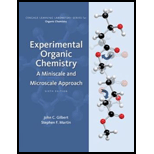
Concept explainers
a)
Interpretation:Difference in melting points of sample with sample tube has height of
Concept introduction:Melting point is temperature that involves conversion of substance from solid to liquid state. Both liquid and solid phases are present in equilibrium with each other at this temperature.
b)
Interpretation:Source of error in measurement of melting point of
Concept introduction:Melting point is temperature that involves conversion of substance from solid to liquid state. Both liquid and solid phases are present in equilibrium with each other at this temperature.
Want to see the full answer?
Check out a sample textbook solution
Chapter 3 Solutions
Experimental Organic Chemistry: A Miniscale & Microscale Approach (Cengage Learning Laboratory Series for Organic Chemistry)
- A group of students performed a melting point experiment to study the physical properties of ionic and covalent solids. The data collected are shown in the table. Solid Sample Melting Point (oC) Time Elapsed (min) Table Sugar (sucrose) 186 18 Table Salt (sodium chloride) 500 (not observed) 30 Paraffin Wax 37 4 Vegetable Lard 50 >5 Using the information contained in the table, what is the BEST explanation for the results?A The melting point of sodium chloride was not observed because ionic solids do not melt, whereas sugar, wax, and lard melted because they are softer than salt.B The melting points of covalently bonded solids tend to be lower than ionic solids. The melting point of sucrose was greater than the wax or the lard because sucrose has stronger bonds than wax or lard.C The melting point of sodium chloride was not observed because ionic solids are composed of positive and negative ions that do not melt; whereas, the…arrow_forwardWhat is the main purpose of recrystallisation? A. Chemists recrystallise solids when they want to change big crystals into small crystals. B. Chemists recrystallise solids that are contaminated with impurities. If done properly, the solid will then recrystallise in a purer form. C. Chemists recrystallise solids when they want to change small crystals into big crystals.arrow_forwardThe measured melting point for each of two samples was 89-91 ˚C, yet a 1:1 mixture of the two had a melting point of 77-83 ˚C. What is the explanation for these results?arrow_forward
- Choose the correct answer choice. Given the statement below, which choice best accounts for these observations?arrow_forwardGeneral Chemistry 4th Edition McQuarrie • Rock • Gallogly Consider the data in the table. Compound HF University Science Books presented by Macmillan Learning Melting point (°C) AHfus (kJ/mol) Boiling point (°C) AHvap (kJ/mol) -83.11 4.577 19.54 25.18 HCl -114.3 1.991 -84.9 17.53 HBr -86.96 2.406 -67.0 19.27 HI -50.91 2.871 Using the data in the table, calculate ASfus and ASvap for HCl. ASfus = ASvap = -35.38 21.16 Determine the entropy change when 6.10 mol HCl(g) condenses at atmospheric pressure. AS = J/(K. mol) J/(K⚫ mol) J/Karrow_forwardksp CaCO3 3.36×10-9 Ca(OH)2 5.02×10-6arrow_forward
- Discuss some applications of simple distillation and steam distillation. Explain why you can use each method for the chosen applicationarrow_forwardDescribe the fractional distillation curve/grapharrow_forwardA theoretical plate is: the theoretical glassware it takes to distill a specific mixture. an evaporation/condensation cycle. a chromatographic technique used to analyze your distillate. a hot plate used to heat the distillation apparatus.arrow_forward
- How could melting point be used to determine if a compound is the same or different if the melting point is the same?arrow_forwardWhat are the functions of the graduated cylinder and distillate in a distillation set-up?arrow_forwardPart D: Volatiles. A 1.232 gram sample of copper complex weighed 0.783 g after heating. What is the percent of volatile material in this sample? If the sample contains 17.4% ammonia, what is the percent water in the sample?arrow_forward
 ChemistryChemistryISBN:9781305957404Author:Steven S. Zumdahl, Susan A. Zumdahl, Donald J. DeCostePublisher:Cengage Learning
ChemistryChemistryISBN:9781305957404Author:Steven S. Zumdahl, Susan A. Zumdahl, Donald J. DeCostePublisher:Cengage Learning ChemistryChemistryISBN:9781259911156Author:Raymond Chang Dr., Jason Overby ProfessorPublisher:McGraw-Hill Education
ChemistryChemistryISBN:9781259911156Author:Raymond Chang Dr., Jason Overby ProfessorPublisher:McGraw-Hill Education Principles of Instrumental AnalysisChemistryISBN:9781305577213Author:Douglas A. Skoog, F. James Holler, Stanley R. CrouchPublisher:Cengage Learning
Principles of Instrumental AnalysisChemistryISBN:9781305577213Author:Douglas A. Skoog, F. James Holler, Stanley R. CrouchPublisher:Cengage Learning Organic ChemistryChemistryISBN:9780078021558Author:Janice Gorzynski Smith Dr.Publisher:McGraw-Hill Education
Organic ChemistryChemistryISBN:9780078021558Author:Janice Gorzynski Smith Dr.Publisher:McGraw-Hill Education Chemistry: Principles and ReactionsChemistryISBN:9781305079373Author:William L. Masterton, Cecile N. HurleyPublisher:Cengage Learning
Chemistry: Principles and ReactionsChemistryISBN:9781305079373Author:William L. Masterton, Cecile N. HurleyPublisher:Cengage Learning Elementary Principles of Chemical Processes, Bind...ChemistryISBN:9781118431221Author:Richard M. Felder, Ronald W. Rousseau, Lisa G. BullardPublisher:WILEY
Elementary Principles of Chemical Processes, Bind...ChemistryISBN:9781118431221Author:Richard M. Felder, Ronald W. Rousseau, Lisa G. BullardPublisher:WILEY





